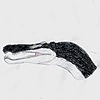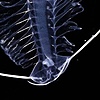HOME | DD
 TrollMans — Brontocorn
TrollMans — Brontocorn

Published: 2022-10-28 08:39:35 +0000 UTC; Views: 27318; Favourites: 457; Downloads: 25
Redirect to original
Description
The early hothouse era is the ultimate heyday of the thorngrazers, those most monstrous of eating machines with all manner of bony facial ornamentations. Within five million years, the original ice age nimicorn experienced a rapid evolutionary radiation into numerous varying forms, even supplanting most of the large avian grazers that it coexisted with, and now vast herds of these grazers collectively numbering hundreds of millions strong roam across the northern supercontinent. In all such species, there was great experimentation and variant on the growths of the skull, creating so many dazzling and unique forms. Some, such as the rumbling helmetheads, have developed hollow chambers to produce a wondrous chorus of echoing calls, while others have augmented their cranial structures into fearsome defensive weapons. The armoured brontocorns are one in the latter category, with impressive and imposing horns which they put to regular and violent use.
The structure and orientation of the brontocorn’s horns is still familiar from its ice age ancestor, but far larger and more robust still; in some cases they may reach nearly four feet in length and over one foot in width at the base. Despite its binomial name, the brontocorn has far more than four horns, although the description derives from its four largest horns at the front of its snout; two larger ones jutting up from the skull, and a smaller pair jutting down from the mandible. Both sexes possess these horns, but they are generally larger in those of males, as they are used for ritual combat between rivals. Duels over females and territory can be fierce, although ironically the horns themselves have little use in such fights beyond visual intimidation and shoving since they are actually too large to make effective stabbing weapons against opponents of similar size.
Brontocorns are large thorngrazers, reaching around four-hundred to five-hundred kilograms as adults (nine-hundred to eleven-hundred pounds), with males reaching larger than females. Brontocorns live as harem animals, with one dominant male defending a herd of females and their offspring. Bachelor males will frequently attempt to sneakily mate with a dominant male’s females or challenge his reign, and he must periodically fend them off or else the females will begin to lose interest in him as a preferred mate. Lesser rivals will usually be cowed without conflict by a dominant male's bright teal facial colours and the size of his horns, but it is often enough that a rival of similar physical stature judges himself an equal or superior. Lacking the acoustic talents of the crested thorngrazers, which help them avoid unnecessary altercations, physical conflicts in such situations are almost inevitable. Fights can be brutal even without stabbing; the impact of two thousand-pound animal crashing into one another, kicking, head-bashing, and biting with their powerful jaws, frequently leaves serious injuries, up to and including broken bones and battered internal organs. Even without serious injuries, these duels can last over an hour and are exhausting for both participants; many predators know this and will circle a battle waiting for a weakened loser to stumble away. A healthy adult brontocorn is a formidable opponent, but softened up after a sustained fight it makes for a much easier target. Expectedly, the average lifespan of a male brontocorn is much shorter than that of the females, particularly the stressful life of an “alpha” male; even without predators, males almost always fall prey to illness as continuous physical combat weakens their bodies. This helps to maintain genetic diversity, as one male will never be able to dominate a herd for too long.
Herds of brontocorns usually reach around one to four dozen adults in number, sometimes up to sixty or seventy, and with an equal number of young amongst them at any time. These herds are incredibly destructive in their feedings, using their lower tusks to churn up the soil in search of burrowing animals, tubers, edible roots, and ripping whole plants right out of the ground, eating it all in huge mouthfuls, dirt and all, leaving behind only piles of dung and barren mud in their wake. Their activities force them into a nomadic existence, roaming far across Serinarcta in the eternal search for fresh pastures, allowing time for fast-growing vegetation to recolonize the desolation they leave in their wake. The size, defensive horns, and armoured hides of the adults leave them with relatively few predators when healthy; they are occasionally hunted by the largest gravediggers, the persistent sawjaw packs capable of overpowering them, or dragged to a murky grave at a waterhole by a crocodile-like river dragon, but most often it is buildup of sickness and parasitic infections in that does them once past adolescence. Females that survive their first year have an average lifespan of between seven and eight years, sometimes reaching up to twelve in exceptional cases, but males are lucky to reach even half this age.
The relative camaraderie of the females helps this greater longevity; one nine-hundred pound thorngrazer is no easy target, but ten or twenty or more together is a nearly impenetrable fortress of huge horns, dental spikes, and muscle. Females walk in close rank, nearly touching one another during treks, and letting out infrasonic rumbles during wider foraging to maintain auditory contact over distances. Ultimately, this is still an inherently selfish instinct, more members you keep in close contact with, the safer you yourself will be as you mingle with the crowd. There are no specific bonds between individuals in a herd, but this could be ultimately for its benefit, herds are quick to accept strangers simply because they do not care about others other than providing an additional meat shield for themselves. Males have no such sociality; members of bachelor herds are only loosely associated and very rarely do any members stay for longer than a few months, while females are quick to abandon the lead bull should they see his physical condition has deteriorated or they deem him to have become an unsuitable sire. This is not a difficult choice when his only real contribution to their lives is his donation of sperm to produce young.
Related content
Comments: 22

👍: 1 ⏩: 0

👍: 0 ⏩: 0

👍: 0 ⏩: 0

👍: 0 ⏩: 0

👍: 1 ⏩: 0

👍: 1 ⏩: 0

👍: 3 ⏩: 1

👍: 2 ⏩: 1

👍: 0 ⏩: 0

👍: 4 ⏩: 0

👍: 4 ⏩: 0

👍: 2 ⏩: 0

👍: 0 ⏩: 1

👍: 1 ⏩: 1

👍: 1 ⏩: 1

👍: 0 ⏩: 0

👍: 0 ⏩: 1

👍: 4 ⏩: 1

👍: 3 ⏩: 0

👍: 0 ⏩: 1

👍: 3 ⏩: 0

















